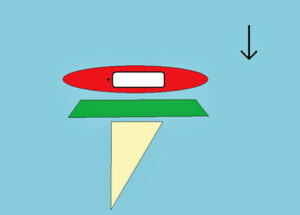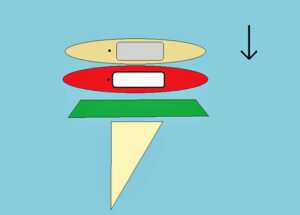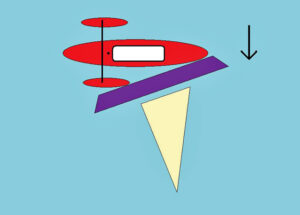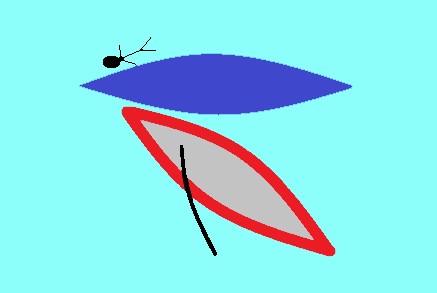The concept of buddying up with one or two others sailing canoes has been around for as long as the sport has existed. When the club formalised how safety is enhanced by using this approach, it raised the issue of what is the most appropriate action to take if one of your buddies capsizes?
First Ask for Help
If you are buddied up in a group of three, ensure that the third member of the party has seen the capsize. Shouting and blowing your whistle may form part of this.
Form a plan. Consider the peculiarities of both your boat and the casualty’s boat. Other factors to be taken into account are the proximity of the shore, the wind strength/direction and wave action. One possible plan, for a casualty who is unable to self-rescue, is described below.
Approach

The next stage is to make contact. One method of doing this is to get upwind of the casualty, drop/furl your rig, and paddle to the casualty. When you arrive let the casualty know what you are planning to do.
Right the boat
Righting the boat will be much simpler if you have the wind blowing over the hull on to the sails as the boat is pulled upright. This stops the wind flipping the boat, and making it re-capsize on top of you. The capsized boat’s leeboard may prove to be a useful lever for righting the capsized boat. If something is not working ask yourself what you need to change. Asking the casualty to remove the capsized boat’s rig may provide a solution (make sure it is attached, usually by the mainsheet having a stopper knot in the end if it runs through a turning block on the boat).
Get the casualty back in the boat
The rescuer steadies the boat from the upwind side (clear of any flapping sails), while the casualty climbs in from the downwind side. The chief barrier to climbing back in is freeboard. Freeboard can be reduced by the rescuer tipping the casualty’s boat, or if necessary, by part filling the casualty’s boat with water.
Empty the boat
The casualty steps/crawls from their own boat into the rescuer’s boat, then the casualty and rescuer roll the casualty’s boat on to its side, to empty out much of the water using the fitted buoyancy to lift the boat as it is rolled back up. The remaining water can be bailed out.
After care
If the casualty is not wearing a wet or dry suit, encourage them to go ashore to get warmed up (you did remember to bring a change of clothes didn’t you?) – Hypothermia is insidious and well worth avoiding.
Alternatives

The rescue described above requires strength and skill on the part of the rescuer. A second boat, rafted up on the upwind side of the rescuer’s boat, will do much to increase both stability and the chances of a successful outcome. The sailor in the upwind boat does not get involved in the rescue and simply concentrates on keeping the rescuer’s boat upright.
Outriggers
While outriggers increase the chances of completing a successful self-rescue, they do pose some problems when assisting others. Outriggers for sailing canoes should be of a size and volume that assists rather than hinders the sailor in performing a peer rescue. The extra stability provided by the Solway Dory design of mini outriggers allow the casualty to climb directly into the rescuer’s boat and (providing they are positioned correctly on the rescuers boat) they still allow a sailor using them to come alongside a capsized boat.

Strategies of last resort
Two key principles are: rescue the person not the boat, and do not put yourself in danger. To this end it may be necessary to abandon the casualty’s boat. If you do this then two rescuers should raft up on each other, and pull the casualty, one limb at a time, into one of the boats. If a second boat is not available and the shore is fairly close, then it may be possible to sail to shore with the casualty clinging to the bow of the rescuer’s boat. Having them at the bow allows the rescuer to monitor the casualty. It is best not to attempt pulling a casualty into a monohull without first rafting up with another boat for stability. To do so is a high-risk strategy that could well result in a serious “all in” situation.
“All in” rescues
If you do find yourself bobbing in the water next to your buddies, then you will have to self-rescue. On the positive side you will have the advantage of having someone to steady your boat while you climb back in.
If the situation feels out of control do not be afraid to call for help using phone or VHF, or set off flares. Studies of canoeing incidents have shown that paddlers often delay calling for help until they are too cold and exhausted to do so successfully. Your would-be rescuers are unlikely to be too concerned if they respond to a distress call but find that you have already managed to get the situation under control yourself.
Another Rescue Approach
The ‘Buddy Rescue’ techniques mentioned so far, for assisting a canoe sailor who is unable to self-rescue, are well tested and have helped to resolve a number of difficult situations. But sometimes the skills required to perform those techniques are beyond many canoe sailors.
Safety in canoe sailing is usually based on a small group of sailors sailing together, as these groups of sailors are often of similar ability. But often if a canoe sailor capsizes, their companions are sailing near the limit of their ability. With this in mind a more easily accomplished method of assisting a capsized sailor is worth knowing.
Typically a capsized canoe sailor will start by attempting a self-rescue. Often the capsized sailor will successfully right their boat, but then find themselves unable to climb back into their canoe. Each unsuccessful attempt at re-entry results in another capsize and after a few rounds of this, the capsized sailor becomes exhausted.
If you see one of your companions begin to enter this cycle of failed self-rescue and capsize, your first step should be to sail within shouting distance of them. Make a quick visual check to ensure that their rig is secured to the canoe by the mainsheet. Some rigs require a tight kicker to keep the boom attached to the mast, so check for this also. At this point shout to the capsized sailor and encourage them to remove/unstep the mast.
Simply encouraging the sailor to remove the mast may make it possible for the sailor to enter the canoe when it is righted. Even if removing the rig does not enable the sailor to self-rescue, the detached rig will act as a sea-anchor to slow the downwind drift of the canoe.
It is easier to approach a stricken canoe by you sailing from downwind, as the wind can be used to control the speed of your own canoe. The principal drawback of a downwind approach is becoming entangled in the rig of the stricken canoe as it is righted, but with the rig already removed this hazard is avoided.

Once you have made contact with the stricken canoe, you should be able to provide assistance. This could be help in righting the canoe, or more likely, assistance in helping the sailor to enter the canoe. Tipping the canoe towards them slightly may help the sailor to enter. Alternatively a loop of rope can be used to provide the sailor with something to stand in while you counterbalance their weight by pushing down on the opposite side of the canoe.
With the sailor returned to the canoe, the rig can be retrieved and stowed, with further progress made by paddling. Often paddling to the nearest downwind landing spot is the best option.